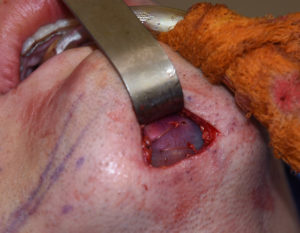The use of a custom jawline implant is the most effective technique to reshaping the lower face. Its one-piece design allows the changes in the front of the jaw (chin) and the back of the jaw (jaw angles) to be connected in a smooth linear fashion.
While the one-piece design of the implant has numerous aesthetic advantages, it does pose a unique intraoperative challenge. How does such a jawline implant get inserted? The sheer size of the implant is completely different than much smaller chin and jaw angle implants which are placed through single incisions.
The custom jawline implant is usually placed through a three incisional approach. There is the two intraoral posterior vestibular incisions and the anterior chin incision. The chin incision can be done either through the skin under the chin or from inside the mouth. Through these three incisions a subperiosteal tunnel is made that connects them going under the exit of the mental nerve from the bone. The custom jawline implant is positioned into place by passing the back parts of the implant through the chin incision
The size of the jaw angle part of the implant determines how easy or hard the custom jawline implant placement technique is. If the jaw angle implant part is very large it may be impossible to pass it under the tunnel that connects the chin and the jaw angle without significant risk of injuring or even tearing the mental nerve.

Dr. Barry Eppley
Indianapolis, Indiana


